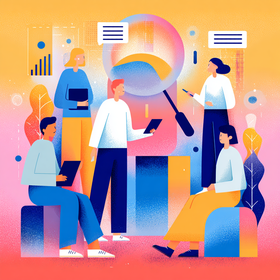D UX Design in the Internet of Things (IoT)
Por Redacción Aguayo
Discover how UX design is transforming the Internet of Things (IoT), optimizing interaction between users and connected devices.

Introduction to the Internet of Things (IoT)
The Internet of Things (IoT) has revolutionized the way we interact with technology and how devices connect and exchange data with each other. This concept is not just a futuristic trend but a reality that is transforming various sectors, from smart homes to manufacturing and healthcare. In this chapter, we will explore what IoT is, how it works, and what implications it has for user experience (UX) design.
Definition and Basic Concept of IoT
The Internet of Things refers to the interconnection of physical devices (such as appliances, vehicles, sensors, etc.) through the internet, enabling them to collect and share data. These devices are equipped with sensors and actuators that allow them to interact with their environment and perform specific tasks automatically. The key to IoT lies in these devices' ability to communicate and cooperate with each other without direct human intervention.
History and Evolution of IoT
The concept of IoT traces back to the idea of "ubiquitous computing" proposed by Mark Weiser in the 1980s, where devices would seamlessly integrate into the human environment. However, it was in the early 21st century when technology and connectivity advanced enough to realize the IoT vision. Over time, the miniaturization of electronic components and the expansion of networks like 5G have further propelled the adoption and development of IoT devices worldwide.
Key Components of IoT
IoT consists of several essential elements that work together to create an interconnected network:
- IoT Devices: These are physical objects that incorporate sensors, actuators, and connectivity to interact with the environment and send data over the internet.
- Connectivity: Networks such as Wi-Fi, Bluetooth, Zigbee, and now 5G enable communication between IoT devices and cloud platforms where data is processed and stored.
- Management Platforms: Cloud-based systems that enable managing large volumes of data generated by IoT devices, performing advanced analytics, and delivering services based on this data.
- User Interfaces: Include physical and digital interfaces through which users interact with IoT devices, such as mobile apps, web dashboards, and voice-enabled devices.
Practical Applications of IoT
IoT has practical applications in a wide range of industries and contexts:
- Smart Home: Control of lights, thermostats, appliances, and security systems through IoT devices.
- Health and Wellness: Remote patient monitoring, connected medical devices, and personal health management.
- Smart Cities: Traffic optimization, waste management, smart lighting, and environmental sensors to improve air and water quality.
- Industry and Manufacturing: Process optimization, predictive maintenance of machinery, inventory tracking, and automated logistics.
Challenges and Ethical Considerations
Despite its benefits, IoT presents significant challenges that need to be addressed:
- Security and Privacy: The vast amount of data generated by IoT devices poses risks to privacy and security if not properly managed.
- Interoperability: IoT devices often come from different manufacturers and may use different communication standards, making integration and joint operation challenging.
- Sustainability: The increasing number of IoT devices raises demands for energy and materials, posing challenges in terms of sustainability and electronic waste management.
Impact of IoT on User Experience (UX) Design
UX design in the context of IoT focuses on creating intuitive and meaningful interfaces that facilitate interaction between users and connected devices. This includes considering accessibility, usability, and seamless integration with other systems and devices. Designers must think about how users will interact with devices in different contexts and ensure that the experience is consistent and satisfactory.
Importance of UX Design in IoT
User experience (UX) design plays a crucial role in the success and effective adoption of the Internet of Things (IoT). As connected devices become more ubiquitous in our lives and environments, the quality of user-device interaction becomes a determining factor for their acceptance and usefulness. In this chapter, we will explore why UX design is critical in the context of IoT and how it can influence the overall user experience.
Facilitating Complex Interaction
One of the biggest challenges of IoT is the inherent complexity in the interaction between multiple devices and platforms. Effective UX design can simplify this complex interaction by providing intuitive interfaces that allow users to effortlessly control and monitor multiple devices. This includes designing clear and consistent workflows that guide users through different usage scenarios, ensuring actions are understandable and accessible to all skill levels.
Improving Usability and Efficiency
Good UX design in IoT focuses on improving the usability and efficiency of connected devices. This involves minimizing friction in interaction, reducing the number of steps required to complete a task, and anticipating user needs before they arise. Well-designed interfaces can anticipate actions based on previous usage patterns, thus simplifying the process of controlling and configuring IoT devices in various contexts, from homes to complex industrial environments.
Creating Consistent and Contextual Experiences
IoT spans across multiple devices and platforms operating in different contexts and environments. Effective UX design in IoT ensures that the user experience is consistent and contextually relevant across all these touchpoints. This means tailoring user interfaces to reflect user preferences, the current environment, and specific conditions of use. For example, IoT devices in a smart home should adjust automatically based on the time of day or user presence to provide a seamless and personalized experience.
Focus on Accessibility and Inclusion
UX design in IoT must also consider accessibility and inclusion, ensuring that devices are accessible to all users, including people with disabilities. This involves using universal design principles to ensure interfaces are understandable and usable by individuals with different abilities and needs. Including accessibility options such as voice commands, tactile touch interfaces, and adjustable font sizes enhances the overall accessibility of IoT and expands its utility to a broader audience.
Building User Trust and Acceptance
Well-thought-out UX design not only enhances the functionality and efficiency of IoT but also builds trust and acceptance among users. Intuitive and secure interfaces can reduce anxiety and resistance to change when interacting with new and complex technologies. Additionally, user-centered design can increase overall user satisfaction by providing smooth and rewarding experiences that meet their expectations and specific needs.
Driving Innovation and Competitiveness
In an increasingly crowded IoT device market, differentiated UX design can be a key factor in driving innovation and competitiveness of products. Companies that invest in deeply understanding user needs and desires through UX design can develop products that not only perform well but also provide a superior experience compared to competitors. This can result in higher customer loyalty and a significant edge in the ever-evolving IoT market.
UX design plays a crucial role in defining the success of the Internet of Things by ensuring that connected devices are useful, accessible, and easy to use for end users. By focusing on facilitating complex interactions, improving usability, creating consistent and contextually relevant experiences, and promoting user inclusion and trust, UX designers can help shape a future where IoT enriches our lives meaningfully and sustainably.
Fundamental Principles of UX Design for IoT Devices
User experience (UX) design for Internet of Things (IoT) devices faces unique challenges and requires specific principles to ensure that users can interact effectively and satisfactorily with connected devices. In this chapter, we will explore the fundamental principles of UX design for IoT and how they can be applied to improve usability, accessibility, and the overall user experience.
1. User-Centered Design
User-centered design is crucial for the success of IoT. This involves understanding the needs, skills, and expectations of end users when interacting with IoT devices. Designers should conduct thorough research to understand usage contexts and design interfaces that are intuitive and easy to navigate, ensuring that devices meet users' real needs.
2. Simplicity and Clarity
Given the inherent complexity of IoT, it is crucial to maintain simplicity and clarity in the design of user interfaces. Users should be able to perform tasks easily and understand the status and functions of devices quickly. This is achieved through the use of clean and minimalist designs, clear iconography, and concise text that effectively guides the user through the device's functions and features.
3. Consistency in Interaction
Consistency in interaction is essential for creating a smooth and predictable experience for users. Design principles should be applied consistently across all IoT platforms and devices, ensuring that interaction and navigation patterns are uniform. This not only facilitates use but also reduces the learning curve and increases user confidence when interacting with different devices in an IoT environment.
4. Adaptability to Different Contexts
IoT devices operate in a variety of contexts and environments. UX design must be adaptable to ensure that interfaces are effective and relevant in different situations. This may include automatic adjustments based on location, user preferences, or environmental changes, ensuring a consistent and optimized experience regardless of where and how devices are used.
5. Feedback and Visual Feedback
Providing clear and visual feedback to the user about actions taken and the current state of the device is fundamental. This may include visual confirmations of completed actions, real-time status indicators, and visual alerts when important events occur. Effective feedback not only informs the user about the system's status but also enhances user confidence and understanding of how to interact with the device.
6. Security and Trust
Security is a central concern in UX design for IoT devices. Users must feel safe when interacting with connected devices, especially when it comes to personal data and privacy. It is crucial to integrate design practices that protect user information, such as secure authentication, data encryption, and appropriate access controls, to ensure a secure and reliable experience.
7. Inclusive and Accessible Design
UX design for IoT must be inclusive and accessible to all users, regardless of their physical or cognitive abilities. This involves offering accessibility options such as voice commands, tactile touch interfaces, and adjustable font size settings. Making IoT devices accessible expands their utility and enhances the experience for a broader and more diverse audience.
8. Continuous Evolution and Updates
UX design for IoT devices does not end with the initial product launch. It is important to plan for the continuous evolution and updates of the design to adapt to new technologies, user needs, and market changes. This may involve design iterations based on usage data, user feedback, and advances in IoT technology to keep devices relevant and effective over time.
By following these fundamental principles of UX design for IoT devices, designers can create user experiences that are not only effective and functional but also intuitive, secure, and satisfying. User-centered design, simplicity, consistency, adaptability, visual feedback, security, accessibility, and continuous evolution are key pillars for designing IoT products that significantly enhance users' lives in today's connected digital environment.
User-Device Interaction in the Context of IoT
User-device interaction in the Internet of Things (IoT) is a fundamental aspect that defines how users interact, control, and communicate with connected devices in their daily lives. In this chapter, we will explore the dynamics of this interaction, the challenges it presents, and how UX design can significantly enhance this relationship to deliver more intuitive and satisfying experiences.
1. Complex Nature of IoT Interaction
Interaction in IoT is complex due to the diversity of devices, platforms, and environments in which they operate. Users can interact with IoT devices from multiple locations and through various interfaces such as mobile applications, web interfaces, and voice commands. UX design must simplify this complexity by providing cohesive interfaces that unify the user experience across different touchpoints.
2. Contextualized and Adaptive Design
Effective UX design in IoT must be contextualized and adaptive, taking into account the changing environments and circumstances in which devices are used. This involves designing interfaces that automatically adjust based on user location, time of day, personal preferences, and other contextual factors. For example, a smart thermostat can adjust the temperature based on user presence at home, thereby enhancing comfort and energy efficiency.
3. Intuitive and Minimalist Interfaces
User interfaces in IoT must be intuitive and minimalist to facilitate navigation and control of devices. This includes using clear iconography, concise text, and consistent visual design to effectively guide users through the device's functions and features. Simplicity in design helps reduce user cognitive load and improves the user experience in everyday situations and dynamic environments.
4. Feedback and Effective Feedback
Providing clear and effective feedback is crucial to improving the user experience in IoT. Devices should offer clear visual responses to actions taken, current status, and any changes in the device's environment. This not only informs the user about the effectiveness of their actions but also increases user confidence and understanding of how to interact with the device in different scenarios.
5. User Personalization and Preferences
IoT allows for personalized user experiences based on individual preferences. Devices should be able to adapt and learn from past interactions to offer recommendations and personalized adjustments. For example, a smart lighting system can automatically adjust light intensity based on user lighting preferences at different times of the day, thereby enhancing comfort and convenience.
6. Security and Privacy
Security and privacy are critical considerations in user-device interaction in IoT. Users must feel safe when sharing data and controlling connected devices. UX design should integrate robust security practices such as multi-factor authentication, data encryption, and appropriate access controls to protect user information and mitigate cybersecurity risks.
7. Scalability and Compatibility
With the proliferation of IoT devices in homes and commercial environments, UX design must consider scalability and compatibility across different devices and platforms. Interfaces should be interoperable and seamlessly integrate with a variety of devices to provide an integrated and consistent experience. This ensures that users can efficiently control and monitor multiple IoT devices.
8. Continuous Evaluation and Iterative Improvement
UX design in the context of IoT requires continuous evaluation and iterative improvement to adapt to changing user needs and technological innovations. This involves collecting usage data, conducting usability testing, and obtaining user feedback to identify areas for improvement and optimization in interface design and device functionality.
Design Strategies to Enhance Usability in IoT Devices
Designing for usability in Internet of Things (IoT) devices is crucial to ensure that users can interact effectively and satisfactorily with connected devices. In this chapter, we will explore various design strategies focused on improving usability in the context of IoT, addressing everything from simplicity and clarity to customization and security.
1. Simplification of User Interface
Simplifying the user interface is crucial for improving usability in IoT devices. Designers should eliminate unnecessary elements and focus on the core functions that users need to control and monitor. This includes using a clean and minimalist layout, intuitive icons, and concise text that effectively guide users through the device's features without confusion.
2. Responsive and Adaptive Design
Responsive and adaptive design is essential to ensure that user interfaces adjust to different screen sizes and devices in the IoT environment. Interfaces should automatically adapt to device characteristics and user preferences, providing a consistent and optimized experience in any usage context.
3. Visual and Auditory Feedback
Providing clear and effective feedback is crucial to improving usability in IoT devices. In addition to visual indicators such as LED lights and changes on the screen, auditory feedback should also be considered for users with visual impairments or in environments where visual feedback may be limited. Distinctive sounds and auditory signals can reinforce visual feedback for a more inclusive and understandable experience.
4. Personalization and Adaptability
Personalization plays a key role in the usability of IoT devices, allowing users to configure and adjust the device according to their individual preferences. This may include the ability to customize control layouts, adjust automation levels, and set personalized schedules for device functions. Adaptability also involves learning from past interactions to anticipate user needs and provide a more intuitive and personalized experience.
5. Security-Centered Design
Security is critical in IoT device design to protect user privacy and prevent unauthorized access. Designers should integrate robust security measures such as data encryption, multi-factor authentication, and automatic software updates to ensure that IoT devices are secure and reliable at all times. Additionally, educating users about best security practices is crucial to mitigate potential risks.
6. Ease of Installation and Setup
Ease of installation and setup is a key aspect of usability in IoT devices, especially for non-technical users. Devices should be easy to install from the first use, with clear instructions and intuitive processes that guide the user through the initial setup. Automating complex steps and auto-detecting networks can further simplify the initial setup process.
7. Inclusive and Accessible Design
Inclusive and accessible design is crucial to improving usability in IoT devices and ensuring that all users, regardless of their physical or cognitive abilities, can interact with devices effectively. This includes offering accessibility options such as voice commands, tactile touch interfaces, and visual contrast settings to enhance text readability.
Case Studies and Practical Examples of UX Design in the IoT
Nest Thermostat
The Nest Thermostat is a classic example of how UX design can transform the smart home user experience. Nest has simplified temperature control with an intuitive interface that learns user preferences and automatically adjusts the climate. Users can control the thermostat both from the physical unit and through a mobile app, providing a consistent and convenient experience.
Philips Hue Lighting System
The Philips Hue lighting system offers advanced UX design by allowing users to control the lights in their home via a mobile app or voice commands. Customization is key, as users can adjust the color and intensity of the light depending on the desired environment. Additionally, the system is compatible with other smart home devices, providing seamless integration and a cohesive user experience.
Fitbit
Fitbit is a leading example of how UX design on wearable devices can improve personal health and well-being. Users can track their physical activity, sleep, and heart rate through a simple and accessible interface. Visual feedback and motivation are key elements of Fitbit's UX design, encouraging users to maintain more active and healthy lifestyles.
Tesla Model S
The Tesla Model S represents a significant advancement in UX design for connected vehicles. The central touchscreen controls all the car's main functions, from navigation to climate control and entertainment. The user interface is intuitive and responsive, with regular updates that continually improve the driver and passenger experience.
Amazon Echo
The Amazon Echo smart speaker exemplifies how UX design can simplify interactions with technology in the home. Equipped with the virtual assistant Alexa, users can perform a variety of tasks with just voice commands, such as playing music, controlling smart home devices, getting weather information, and more. The ability to learn and adapt to user preferences improves the usability and accessibility of the device.
Philips CitySense
CitySense is a smart urban lighting system developed by Philips that uses IoT sensors to adjust light intensity based on environmental conditions and the presence of people. This system not only improves energy efficiency by reducing electricity consumption, but also increases the safety and comfort of residents by providing lighting adapted to the real needs of the urban environment.
Future Perspectives and Recommendations for Designers
UX design in the Internet of Things (IoT) represents an exciting and challenging opportunity for designers in today's digital age. As we continue to innovate and expand the capabilities of connected devices, it is essential to reflect on future prospects and provide key recommendations for designers seeking to optimize the user experience in this dynamic and evolving context.
Integration of Emerging Technologies
The future of UX design in IoT is closely linked to the integration of emerging technologies such as artificial intelligence (AI), machine learning, and augmented reality (AR). These technologies have the potential to further personalize user interactions, anticipate user needs, and improve the operational efficiency of IoT devices. Designers must be prepared to explore how these technologies can transform and enrich the user experience.
Focus on Sustainability and Ethics
As the IoT grows in scale and complexity, it is crucial that designers prioritize environmental sustainability and ethics in the design of products and services. This includes minimizing resource consumption, reducing electronic waste, and ensuring transparency in the collection and use of user data. Designers have a responsibility to create solutions that are not only effective and efficient, but also ethically responsible and environmentally friendly.
Continuous Improvement and User Feedback
Continuous improvement based on user feedback is essential for the success of UX design in IoT. Designers must establish effective mechanisms to collect feedback, analyze usage data, and conduct usability testing on a regular basis. This allows you to identify areas for improvement, resolve usability issues, and adjust the user interface to meet the changing needs and expectations of the end user.
User-Centered Design and Accessibility
User-centered design and accessibility must be fundamental pillars in the development of IoT devices. Designers must consider the diverse skills, needs, and preferences of users when designing intuitive and easy-to-use interfaces. This includes offering accessibility options such as voice commands, haptic touch interfaces, and visual contrast adjustments to ensure that all users can interact effectively with IoT devices.
Interdisciplinary Collaboration
The success of UX design in IoT also depends on interdisciplinary collaboration between designers, software engineers, data scientists, and cybersecurity experts. Working as a team allows us to comprehensively address the technical and ethical challenges associated with the design of connected devices, ensuring robust and well-integrated solutions in the market.
Education and Professional Development
Given the rapid technological advancement in the field of IoT, it is essential that designers continue to educate themselves and develop their professional skills. Participating in continuing education courses, conferences, and professional networks helps you stay up to date with the latest trends, tools, and best practices in UX design for IoT devices.
Adaptability and Flexibility
UX design in IoT must be adaptable and flexible to respond to rapid changes in user preferences and technological advances. Designers must be willing to iterate on their designs, experiment with new ideas, and adapt to ever-evolving market needs and user demands.
Future perspectives
The future of UX design in the IoT promises to be exciting and full of possibilities. With the continued evolution of technology and the growing adoption of connected devices, designers will play a crucial role in creating intuitive, personalized and secure user experiences. By adopting a user-centric, ethical and sustainable approach, designers can significantly contribute to improving quality of life and efficiency in various aspects of our daily lives.



























































































































































































































